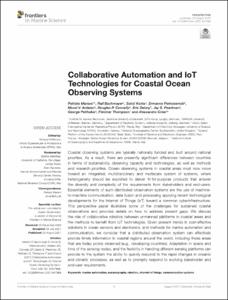| dc.contributor.author | Mariani, Patrizio | |
| dc.contributor.author | Bachmayer, Ralf | |
| dc.contributor.author | Kosta, Sokol | |
| dc.contributor.author | Pietrosemoli, Ermanno | |
| dc.contributor.author | Ardelan, Murat V. | |
| dc.contributor.author | Connelly, Douglas P. | |
| dc.contributor.author | Delory, Eric | |
| dc.contributor.author | Pearlman, Jay S. | |
| dc.contributor.author | Petihakis, George | |
| dc.contributor.author | Thompson, Fletcher | |
| dc.contributor.author | Crise, Alessandro | |
| dc.date.accessioned | 2021-09-03T19:15:24Z | |
| dc.date.available | 2021-09-03T19:15:24Z | |
| dc.date.issued | 2021 | |
| dc.identifier.citation | Mariani, P., Bachmayer, R., Kosta, S.,
Pietrosemoli, E., Ardelan, M.V.,
et al (2021) Collaborative Automation
and IoT Technologies for Coastal
Ocean Observing Systems.
Frontiers in Marine Science, 8:647368, 8pp. DOI: 10.3389/fmars.2021.647368 | en_US |
| dc.identifier.uri | https://repository.oceanbestpractices.org/handle/11329/1720 | |
| dc.description.abstract | Coastal observing systems are typically nationally funded and built around national
priorities. As a result, there are presently significant differences between countries
in terms of sustainability, observing capacity and technologies, as well as methods
and research priorities. Ocean observing systems in coastal areas must now move
toward an integrated, multidisciplinary and multiscale system of systems, where
heterogeneity should be exploited to deliver fit-for-purpose products that answer
the diversity and complexity of the requirements from stakeholders and end-users.
Essential elements of such distributed observation systems are the use of machine-
to-machine communication, data fusion and processing applying recent technological
developments for the Internet of Things (IoT) toward a common cyberinfrastructure.
This perspective paper illustrates some of the challenges for sustained coastal
observations and provides details on how to address present gaps. We discuss
the role of collaborative robotics between unmanned platforms in coastal areas and
the methods to benefit from IoT technologies. Given present trends in cost-effective
solutions in ocean sensors and electronics, and methods for marine automation and
communication, we consider that a distributed observation system can effectively
provide timely information in coastal regions around the world, including those areas
that are today poorly observed (e.g., developing countries). Adaptation in space and
time of the sensing nodes, and the flexibility in handling different sensing platforms can
provide to the system the ability to quickly respond to the rapid changes in oceanic
and climatic processes, as well as to promptly respond to evolving stakeholder and
end-user requirements. | en_US |
| dc.language.iso | en | en_US |
| dc.rights | Attribution 4.0 International | * |
| dc.rights.uri | http://creativecommons.org/licenses/by/4.0/ | * |
| dc.subject.other | Automation | en_US |
| dc.subject.other | Robotics | en_US |
| dc.subject.other | Internet of Things | en_US |
| dc.subject.other | Communication systems | en_US |
| dc.title | Collaborative Automation and IoT Technologies for Coastal Ocean Observing Systems. | en_US |
| dc.type | Journal Contribution | en_US |
| dc.description.refereed | Refereed | en_US |
| dc.format.pagerange | 8pp. | en_US |
| dc.identifier.doi | 10.3389/fmars.2021.647368 | |
| dc.subject.parameterDiscipline | Physical oceanography | en_US |
| dc.bibliographicCitation.title | Frontiers in Marine Science | en_US |
| dc.bibliographicCitation.volume | 8 | en_US |
| dc.bibliographicCitation.issue | Article 647368 | en_US |
| dc.description.sdg | 14.a | en_US |
| dc.description.eov | N/A | en_US |
| dc.description.methodologyType | Method | en_US |
| dc.description.methodologyType | Reports with methodological relevance | en_US |
| obps.contact.contactname | Patrizio Mariani | |
| obps.contact.contactemail | pmar@dtu.dk | |
| obps.resourceurl.publisher | https://www.frontiersin.org/articles/10.3389/fmars.2021.647368/full | |
 Repository of community practices in Ocean Research, Applications and Data/Information Management
Repository of community practices in Ocean Research, Applications and Data/Information Management

